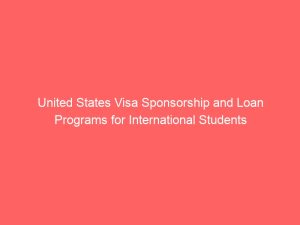The United States remains one of the most attractive destinations for entrepreneurs from all around the world. Whether you are a small business owner looking to expand or a visionary with a start-up idea, the U.S. market offers a diverse range of opportunities. However, entering the U.S. as an entrepreneur often involves two major hurdles—securing a visa that allows you to operate your business and obtaining financing through a business loan to turn your vision into reality. This comprehensive guide will explore the relationship between U.S. business loans and visa sponsorship, detailing the pathways available, eligibility requirements, challenges, and tips for success.
Understanding the U.S. Entrepreneur Visa Landscape
Before seeking a business loan, it’s crucial to understand which visas are available for entrepreneurs. The United States offers several visa categories that allow foreign nationals to start and run a business. Some of these visas can lead to permanent residency, while others are temporary. The most common include:
E-2 Treaty Investor Visa
The E-2 visa is designed for nationals of countries that have a treaty of commerce with the United States. Entrepreneurs must invest a substantial amount of capital in a U.S. business and be actively involved in its operations. While the E-2 does not directly provide a green card, it allows the visa holder to remain in the U.S. for as long as the business is operational.
L-1 Intracompany Transfer Visa
The L-1 visa is suitable for entrepreneurs who already own or work for a business abroad and want to open a branch, subsidiary, or affiliate in the U.S. This visa allows executives, managers, and specialized knowledge employees to transfer to the U.S. entity.
EB-5 Immigrant Investor Program
The EB-5 visa offers a direct path to a green card for entrepreneurs willing to invest at least $800,000 (in targeted employment areas) or $1.05 million in a U.S. business that creates at least 10 full-time jobs for American workers.
O-1 Visa for Individuals with Extraordinary Ability
The O-1 visa can apply to entrepreneurs with a proven track record of extraordinary achievements in their field, even if they do not have significant capital to invest.
Visa Sponsorship in the Entrepreneur Context
When we talk about visa sponsorship for entrepreneurs, the concept differs from traditional employment sponsorship. In many cases, the entrepreneur is sponsoring themselves through their own business. For example, an E-2 applicant uses their investment as the basis for the visa, while EB-5 applicants use their capital injection and job creation potential. However, there are scenarios where an established U.S. company can sponsor a foreign entrepreneur as a business partner, consultant, or executive.
Self-sponsorship is a critical aspect of the entrepreneur visa process. It means that rather than relying on an employer to petition for your visa, you create the qualifying conditions yourself. For instance, under the EB-5 program, the “sponsorship” comes in the form of meeting the investment and job creation requirements.
Business Loans for Foreign Entrepreneurs in the U.S.
One of the biggest challenges for foreign entrepreneurs is securing financing in the U.S., particularly if they are not yet permanent residents or citizens. However, several options are available:
SBA Loans
Small Business Administration (SBA) loans are partially guaranteed by the U.S. government, making them attractive for lenders and borrowers. While most SBA lenders prefer applicants with a green card or citizenship, certain programs may be available to non-citizens with valid work visas.
Private Bank Loans
Some U.S. banks offer loans to foreign nationals who have a U.S. business entity and a proven ability to repay. Lenders will assess your creditworthiness, business plan, and collateral.
Alternative Lenders
Non-traditional lenders and online financing platforms can provide capital to foreign entrepreneurs, often with fewer restrictions than banks. These loans may have higher interest rates but can be easier to obtain.
Venture Capital and Angel Investors
If your business idea is innovative and has high growth potential, you might secure funding from U.S.-based venture capital firms or angel investors. While this is not a traditional loan, it is a form of financing that can help you launch and scale your business.
Business Credit Cards and Lines of Credit
Once you establish your business entity in the U.S., you may qualify for business credit cards and revolving credit lines, which can help with operational expenses.
The Intersection of Loans and Visa Sponsorship
Securing a business loan and obtaining a visa are interconnected for entrepreneurs. In many cases, proof of adequate funding is a requirement for a business visa. For example, the E-2 visa requires a “substantial investment,” which can be partially funded through loans as long as the financing is secured by personal assets and not solely the assets of the U.S. business.
On the other hand, lenders may be hesitant to provide financing unless you have legal authorization to work and reside in the U.S., creating a catch-22 situation. This is why strategic planning is essential—sometimes you may need to secure provisional funding before applying for your visa, and in other cases, you might obtain your visa first and then approach lenders.
Steps to Secure a U.S. Business Loan and Visa Sponsorship
- Choose the Right Visa Path – Select the visa type that best fits your situation, investment capacity, and long-term goals.
- Develop a Strong Business Plan – Both immigration authorities and lenders will want to see a detailed business plan with realistic projections.
- Establish a U.S. Business Entity – Register your company in the state where you plan to operate. This is often a requirement for loans and visas.
- Build Your Credit Profile – If possible, establish a U.S. bank account and start building a credit history.
- Secure Initial Capital – Demonstrate to immigration officials that you have funds ready for investment. This can include personal savings, international loans, or investor commitments.
- Apply for the Visa – Submit your visa application with all supporting documents, including proof of investment and business viability.
- Approach Lenders – Once you have legal status or a pending visa application, apply for loans with banks, SBA lenders, or alternative financing sources.
Challenges and How to Overcome Them
Lack of U.S. Credit History
Most lenders rely heavily on credit history when approving loans. Without it, you may need to provide larger collateral, use co-signers, or explore alternative financing.
Visa Limitations
Some visas have restrictions on the type of work you can do or the duration of stay, which can impact loan terms. It’s important to choose a visa that aligns with your long-term business plans.
Legal and Regulatory Compliance
Both immigration and financial regulations in the U.S. can be complex. Hiring an immigration attorney and a financial advisor with experience in international entrepreneurship can save you costly mistakes.
Currency and Tax Considerations
International entrepreneurs must navigate exchange rate fluctuations, U.S. taxation rules, and potentially double taxation depending on their home country’s agreements with the U.S.
Tips for Success
- Start networking early with U.S.-based investors and business partners.
- Keep meticulous financial records to satisfy both immigration authorities and lenders.
- Stay updated on changes to U.S. immigration law that could affect visa availability.
- Consider phased investment—start with a smaller operation and expand as your visa status and financing improve.
- Explore U.S. government programs and local incentives for businesses in specific industries or regions.
Future Outlook for Entrepreneur Visas and Financing
The U.S. continues to recognize the value that foreign entrepreneurs bring to the economy. While immigration policies may shift depending on political climates, programs like EB-5 and E-2 have remained steady sources of opportunity for investors. Similarly, the growth of alternative lending platforms is expanding access to capital for international entrepreneurs.
As global economies become more interconnected, the opportunities for combining U.S. visa sponsorship and business loans are likely to grow. Entrepreneurs who are proactive, informed, and willing to adapt will be in the best position to take advantage of these evolving possibilities.
Conclusion
Navigating the dual challenges of securing a U.S. business loan and obtaining visa sponsorship as an entrepreneur is no small feat. It requires a blend of strategic planning, legal understanding, and financial preparedness. By choosing the right visa, building a strong business foundation, and exploring diverse financing options, foreign entrepreneurs can not only gain entry into the U.S. market but also thrive within it. The journey may be complex, but the rewards—access to one of the world’s largest consumer markets, a stable business environment, and the potential for permanent residency—make it a goal worth pursuing for ambitious entrepreneurs worldwide.




